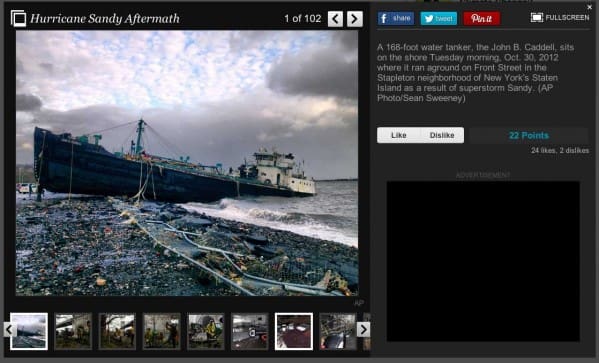Major news outlets use Storify to aggregate & make sense of social media flow about Hurricane Sandy
In the last two days, as we’ve all been inundated (pardon the lame water-related pun) with near-constant TV, radio, web & social media updates on the progress of Hurricane Sandy, one thing that stands out this time around (as opposed to previous disasters) is that, having had time to prepare, the major media outlets turned to Storify to pull together live coverage of the storm, via the thousands (millions?) of ad-hoc citizen reporters who were posting so many TwitPics and Facebook updates.

The front page design of Storify has gotten much better over the past year, and shows the clear stamp of the current trend towards “Pinteresting” everything. Still, when you look at the content mix that has made it to the front page, you can see just how widespread the Storification of Sandy has been…
One of the best uses for Storify has been the excellent attempt by Katie Rogers of the Washington Post to try to enlist readers to try to call bullshit on faked photos of Hurricane Sandy damage. Which is smart on three levels:
- It shows understanding of social media – that every great event will bring out the trolls, who want to prank people with outrageous images/stories.
- That the evolving job of professional journalists is to be the place where the audience can turn to find out if what they have read/seen/heard via social media channels is actually true.
- That journalists alone cannot fulfill this job without the help of said audience.
In the past, we’d have to rely on the efforts of teams of photojournalists to comb over the wreckage, to find the enduring images, and then find a functioning film-development shop to soup the rolls of Tri-X or Kodak 400, and then try to get them to a still-functioning newspaper office to either get the shots on the AP wire, or get them onto the printing presses. I know – I covered the 1989 San Francisco earthquake under just such a set of circumstances.
Now, the day after, there is an entire slideshow on Huffington Post, aggregating the most mind-blowing photos of the damage:
Back then, the LA Times sent a team of 75 reporters to San Francisco. Back then, competing journos (like me) enviously called it “unleashing the swarm of flying monkeys.” Everywhere you turned, there was someone from the LA Times with a notebook and a shooter in tow. There were even two people on the LA Times team whose sole function was JUST TO KEEP EVERYONE’S CELLPHONE BATTERIES CHARGED.
There were blocks and blocks of live TV trucks all around the collapsed I-880 freeway in downtown Oakland, including the monstrous 18-wheeler sized mobile satellite uplinks that we dubbed “mini-Death Stars” that were then the only way to get a signal out from a rubbled disaster site to the rest of the world.
That kind of expensive coverage has been replaced by Storify. And instead of 75 reporters, there are now thousands. Reporting in real-time. Photos instantly spreading around the world.
Better this way? Worse? Or just more difficult to keep track of in the moment … but ultimately, giving us a much more detailed, and immediate sense of what is actually happening in the world?

